Class 4 Maths Mela Chapter 8 Weigh It Pour It NCERT Solutions
Here, you can find Class 4 Mela Chapter 8: Weigh It Pour It NCERT Solutions, which will help students understand the important concepts of Chapter 8: Weigh It Pour It from the Class 4 Maths textbook, Maths Mela. All questions from the respective chapter have been answered with simple and easy-to-comprehend solutions.
Class 4 Maths Mela Chapter 8 Weigh It Pour It Question Answer – PDF Download
NCERT Textbook (Page 115)
Q. In Grade 3, we learnt about measuring weight and capacity. Do you remember the 1-kilogram salt packet and 1 litre bottle? Let us learn some more about measuring weight and capacity.
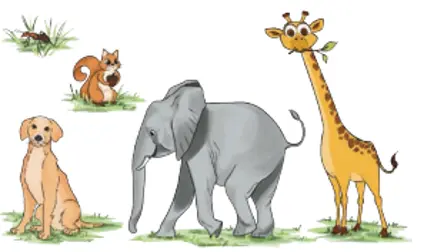
1. Look at the pictures given and write the names of the animals from heaviest to lightest.
Solution:
Elephant > Giraffe > Dog > Squirrel > Ant.
2. Write the name of the heaviest object in your home. How did you know?
Solution:
The car is the heaviest object in our home. I know this because it weighs more than anything else.
3. Do you carry your school bag with ease or with some effort?
Solution:
I can’t lift my school bag easily. I have to put in some effort.
4. Write the name of the heaviest book in your bag. How did you know?
Solution:
My social studies book is the heaviest book in my bag. I know this because it feels heavier than the other books.
5. What is your weight? How did you know?
Answer:
My weight is 28 kilograms. I know this because I have checked it using a weighing scale.
Fun at Vegetable Market! (Page 115)
Rita and Shabnam went to the market to buy some fruits and vegetables. They saw the vegetable seller weighing vegetables.

Q. What do you think will be the weight of the half pumpkin? ________
Solution:
The weight of the full pumpkin = 1 kg or 1000 g.
The weight of the half pumpkin = ½ kg or 500 g.
Let Us Do (Page 116)
Q. Estimate the weight of the following and put a tick mark (✔️) in the appropriate cell. Try to verify if your guess is correct by using a weighing balance.
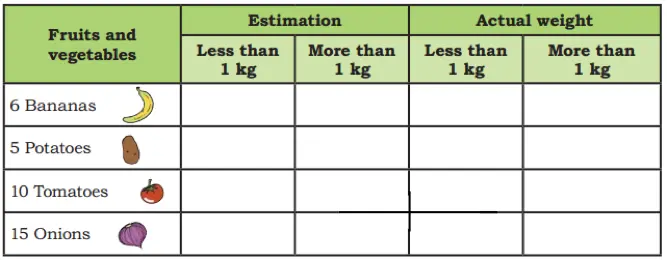
Solution:
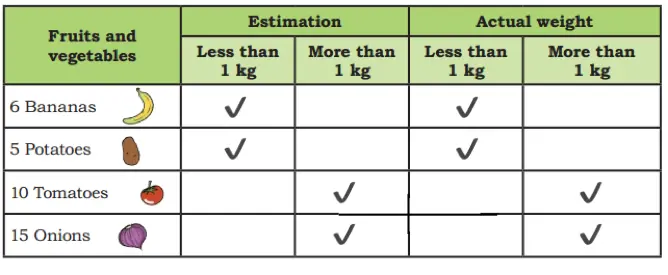
Let Us Explore (Page 116)
a. Look at the picture. You may also try doing the same.
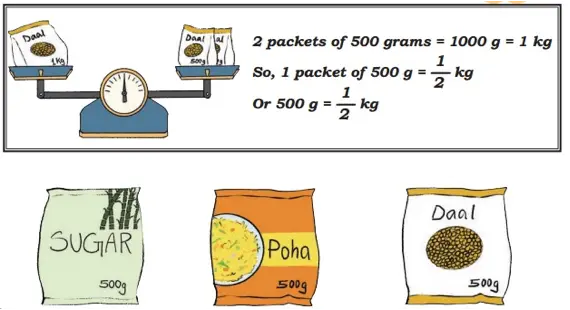
Solution:
Do it yourself.
b. Look at the picture. You may also try doing the same.
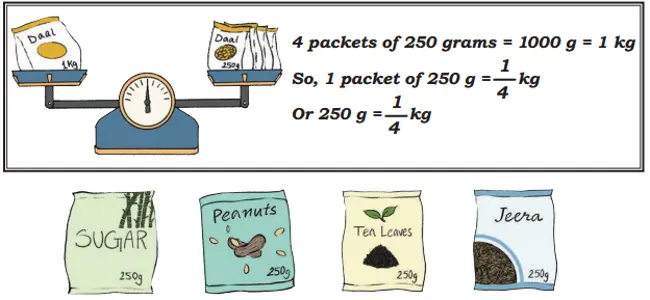
Solution:
Do it yourself.
c. Look at the picture. You may also try doing the same.
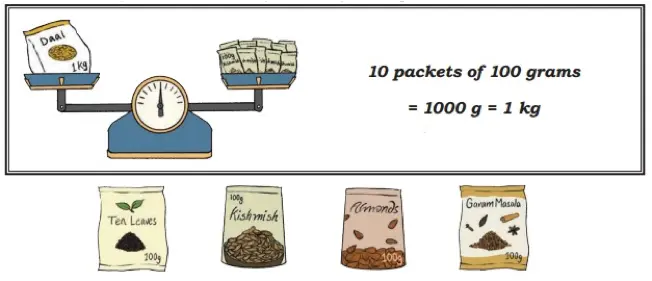
Solution:
Do it yourself.
Let Us Find (Page 117)
1. How many 250 g daal packets will balance one 500 g daal packet?
Draw as many packets of 250 g on the empty pan such that it balances the 500 g packet shown on the left pan of the balance.
What did you find?
250g = _______ of 500 g (1/2 , 2)
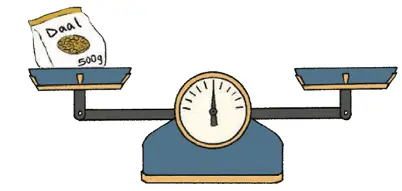
Solution:
2 packets of 250 g daal packets will balance one 500 g daal packet because 250 g + 250 g = 500 g.
We found that 250g = ½ of 500 g.
2. Draw arrows to indicate which side the pan balance will tilt? One is shown for you.

Solution:
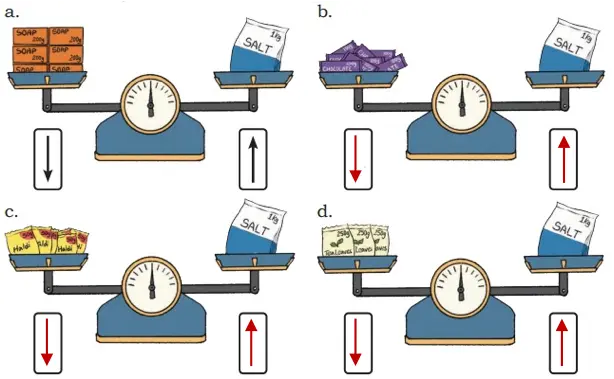
3. Match the unit convenient for measuring each of the following objects?
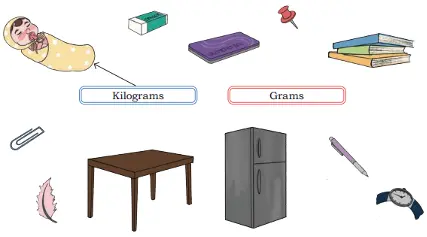
Solution:
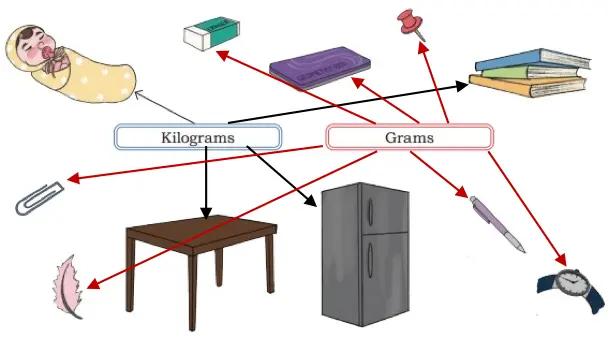
Let Us Do (Page 119)

1. How many erasers will weigh the same as a 50 g Haldi packet? ______
Solution:
1 eraser = 10 g
50 g = 5 × 10 g = 5 erasers.
Therefore, 5 erasers will weigh the same as a 50 g Haldi packet.
2. A 100 g soap bar will weigh the same as __________ erasers.
Solution:
1 eraser = 10 g
100 g = 10 × 10 g = 10 erasers.
Therefore, a 100 g soap bar will weigh the same as 10 erasers.
3. _________ erasers will weigh the same as 250 g sugar.
Solution:
1 eraser = 10 g
250 g = 25 × 10 g = 25 erasers.
Therefore, 25 erasers will weigh the same as 250 g sugar.
Let Us Think (Page 119)
Boxes of Sweet
Mr. Shrinathan, a sweet shop owner, has several orders for 1 kg Kaju-katli but he has to pack them in different sized boxes.
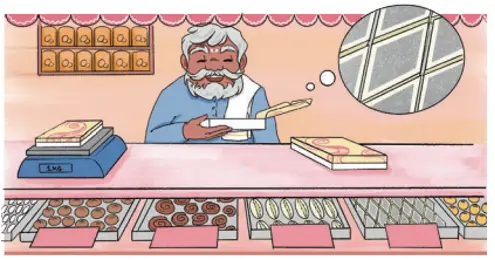
Q. Write down the number of boxes needed to pack 1 kg Kaju-katli in the blank space:
1. Mr. Das wants the sweets in boxes weighing 500 g each. _____________
Solution:
Mr. Das wants the sweets packed in boxes weighing 500 g each.
Since 1 kg = 1000 g, and 500 g + 500 g = 1000 g.
Therefore, he would need 2 boxes of 500 g to pack 1 kg of Kaju Katli.
2. Mrs. Fernandes wants the sweets in boxes weighing 250 g each. ______________
Solution:
Mrs. Fernandes wants the sweets packed in boxes weighing 250 g each.
Since 1 kg = 1000 g, and 4 × 250 g = 1000 g.
Therefore, she would need 4 boxes of 250 g to pack 1 kg of Kaju Katli.
3. Mrs. Khan wants the sweets in boxes weighing 100 g each. ____________
Solution:
Mrs. Khan wants the sweets packed in boxes weighing 100 g each.
Since 1 kg = 1000 g, and 10 × 100 g = 1000 g.
Therefore, she would need 10 boxes of 100 g to pack 1 kg of Kaju Katli.
4. Mr. Patel wants the sweets in boxes weighing 50 g each. ___________
Solution:
Mrs. Khan wants the sweets packed in boxes weighing 50 g each.
Since 1 kg = 1000 g, and 20 × 50 g = 1000 g.
Therefore, she would need 20 boxes of 50 g to pack 1 kg of Kaju Katli.
Weighing Machines (Page 120)
Q. Do you know the different types of weighing machines used to weigh different objects?
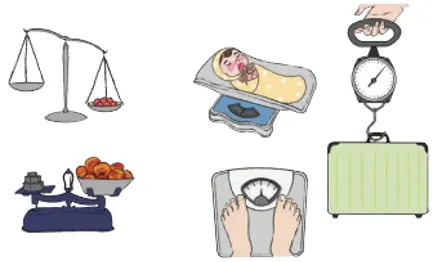
Solution:
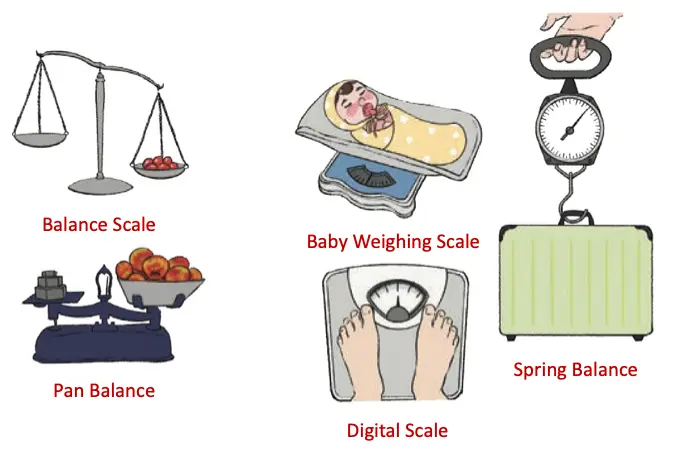
Let Us Do (Page 120)
Q. Ask your parents and find the amount of consumption of the following items at your home in a month.

Solution:
Do it yourself.
Q. Taran and his sister are lifting packets of flour, rice and salt.
What do you think they are experiencing while lifting these packets?
Have you ever lifted such packets at your home? What do you experience? Discuss

Solution:
Tara and his sister are experiencing difficulty in lifting the 10 kg wheat flour and the 5 kg rice bags. The bags are heavy for them, and they cannot lift them even with both hands.
On the other hand, Tara and his sister can easily carry the 1 kg salt packets with one hand. Yes, I lift such packets at home.
For me, the 10 kg and 5 kg packets are too heavy to lift, while I can easily lift the 1 kg packets.
Let Us Do (Page 121)
1. Try to lift some objects around you and write the names of three objects that you can lift easily. Estimate and write their weights.
1. ________
2. ________
3. ________
Solution:
1. Water bottle — about 1 kg
2. School bag (half-filled) — about 3 kg
3. Notebook — about 500 g
2. Now write the name of things that you can lift with a lot of effort. Estimate and write their weights.
1. ________
2. ________
3. ________
Solution:
1. A bucket full of water — about 15 kg
2. A sack of wheat — about 30 kg
3. A heavy chair — about 12 kg
3. How many 1 kg packets are in
a. 10 kg : ______________ c. 50 kg : ______________
b. 20 kg : ______________ d. 25 kg : ______________
Solution:
a. 10 × 1 kg = 10 kg
So, 10 kg : 10 packets.
b. 20 × 1 kg = 20 kg
So, 20 kg : 20 packets.
c. 50 × 1 kg = 50 kg
So, 50 kg : 50 packets.
d. 25 × 1kg = 25 kg
So, 25 kg : 25 packets.
4. Match the objects in the left column with their estimated weights in the right column.

Solution:

Measuring Capacity (Page 122)
Q. Do you remember the 1 litre bottle? How much water does your water bottle hold?
Find bottles and containers that can hold the following quantities of water. Write their names in the appropriate columns in the table given below.

Solution:
Do it yourself
Q. Take help from your teachers and parents to collect different bottles with different capacities – 500 ml, 250 ml, 100 ml, 50 ml and 10 ml.
Try to fill one litre bottle with the water contained in different smaller bottles.
Solution:
Do it yourself.
Let Us Find (Page 123)
a) How many 500 ml bottles will fill a 1 l bottle?
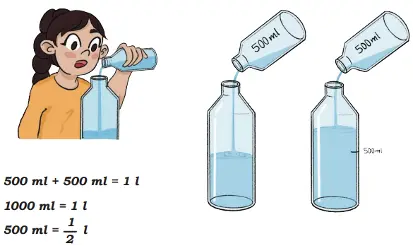
Solution:
1 l = 1000 ml = 500 ml + 500 ml = 2 × 500 ml.
Therefore, two 500 ml bottles will fill a 1 l bottle.
(b) How many 250 ml bottles will fill 1 l bottle?

Solution:
1 l = 1000 ml = 250 ml + 250 ml + 250 ml + 250 ml = 4 × 250 ml.
Therefore, four 250 ml bottles will fill 1 l bottle.
(c) How many 100 ml bottles will fill a 1 l bottle?

Solution:
1 l = 1000 ml = 100 ml + 100 ml + 100 ml + 100 ml + 100 ml + 100 ml + 100 ml + 100 ml + 100 ml + 100 ml = 10 × 100 ml.
Therefore, ten 100 ml bottles will fill a 1 l bottle.
(d) How many:
(i) 250 ml in 1/2 l = ________
(ii) 250 ml in 750 ml = ________
(iii) 100 ml in 1/2 l = ________
(iv) 100 ml in 800 ml = ________
Solution:
(i) 1/2 l = 500 ml
500 ml = 250 ml + 250 ml = 2 × 250 ml.
Therefore, 250 ml in 1/2 l = 2.
(ii) 750 ml = 250 ml + 250 ml + 250 ml = 3 × 250 ml.
Therefore, 250 ml in 750 ml = 3.
(iii) 1/2 l = 500 ml
500 ml = 100 ml + 100 ml + 100 ml + 100 ml + 100 ml = 5 × 100 ml.
Therefore, 100 ml in 1/2 l = 5.
(iv) 800 ml = 100 ml + 100 ml + 100 ml + 100 ml + 100 ml + 100 ml + 100 ml + 100 ml = 8 × 100ml.
Therefore, 100 ml in 800 ml = 8.
Let Us Do (Page 124)
1. Find a dosing cup or a bottle of 10 ml and try to find how many 10 ml will fill a 100 ml bottle __________________
Find how many
a) 10 ml dosing cups will fill a 250 ml glass? ___________
b) 10 ml dosing cups will fill a 500 ml vessel? ___________
c) 10 ml dosing cups will fill a 1l bottle? ___________
Solution:
100 ml = 10 × 10 ml.
Therefore, ten 10 ml dosing cups will fill a 100 ml bottle.
(a) 250 ml = 25 × 10 ml.
Therefore, twenty-five 10 ml dosing cups will fill a 250 ml glass.
(b) 500 ml = 50 × 10 ml.
Therefore, fifty 10 ml dosing cups will fill a 500 ml vessel.
(c) 1 l = 1000 ml = 100 × 10 ml
Therefore, a hundred 10 ml dosing cups will fill a 1 l bottle.
2. Take a 1 ml dropper and find out:
a) How many 1 ml droppers will fill a 10 ml dosing cup? _____________
b) How many droppers will fill a teaspoon? _____________
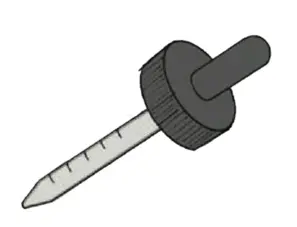
Solution:
(a) 10 ml = 10 × 1 ml.
Therefore, ten 1 ml droppers will fill a 10 ml dosing cup.
(b) Capacity of a teaspoon = 5 ml.
5 ml = 5 × 1 ml.
Therefore, five 1 ml droppers will fill a teaspoon.
3. Find out how much of these liquids are used at a time.
(a) Eye drops Less than 1 ml at a time.
(b) Honey _______________________
(c) Syrup _______________________
(d) Cooking Oil _______________________
(e) ________ _______________________

Solution:
Do it yourself.
4. Mr Krishna packages perfumed oils in different sized bottles. During a festival, the following customers asked for 1l perfumed oils but in different sized bottles. Write the number of bottles each of them will get.
a) Ms Shetty wants bottles of 500 ml each_______
b) Mr Muthu kumar wants bottles of 200 ml each_______
c) Ms Naini wants bottles of 100 ml each _______
d) Ms Kannan wants bottles of 50 ml each_______
Solution:
(a) 1 l = 1000 ml = 500 ml + 500 ml.
Therefore, Ms. Shetty wants 2 bottles, each with a capacity of 500 ml.
(b) 1 l = 1000 ml = 200 ml + 200 ml + 200 ml + 200 ml + 200 ml.
Therefore, Mr. Muthu kumar wants 5 bottles, each with a capacity of 200 ml.
(c) 1 l = 1000 ml = 10 × 100 ml.
Therefore, Ms. Naina wants 10 bottles, each with a capacity of 100 ml.
(d) 1l = 1000 ml = 20 × 50 ml.
Therefore, Ms. Kannan wants 20 bottles, each with a capacity of 50 ml.
5. Estimate and verify by measuring. Use the bottles you have collected for this purpose (for example, 500 ml, 250 ml, 100 ml, 50 ml, and 10 ml).
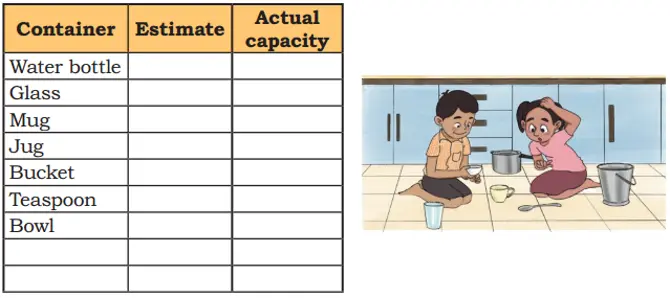
Solution:
Do it yourself.
Let Us Explore (Page 125 – 126)
Q. Visit nearby shops and make a list of different items that are sold in the following quantities.


Solution:

Let Us Find (Page 126)

(a) How many litres of water do you drink in a day? How did you find out?
Solution:
I drink about 2 litres of water in a day. I found it by counting the number of bottles or glasses I drink.
(b) How much water can a crow drink at a time?
Solution:
A crow can drink a few milliliters of water at a time.
(c) How much milk do you drink in one day?
Solution:
I drink about 250 ml of milk in a day.
(d) How much water does an elephant drink in a day?
Solution:
An elephant drinks around 100 to 200 litres of water in a day.
Q. What do you use the most water for? What do you use the least water for? Compare this with a few others in your grade. In which activities is your water usage the same?
Solution:
I use the most water for bathing and washing clothes.
I use the least water for drinking.
When I compared with my friends, I found out that we use the most water for bathing and the least for drinking.
Our water usage is the same for drinking and brushing our teeth.
Q. How much water may be used in the following activities?
a. Water for taking a shower
b. Watering crops in a field?
c. Watering flowering plants
d. Washing clothes
Solution:
a. Water for taking a shower: About 40 to 60 litres per shower.
b. Watering crops in a field: Hundreds or even thousands of litres, depending on the size of the field.
c. Watering flowering plants: About 10 to 15 litres per day (depending on the number of plants).
d. Washing clothes: Around 100 to 200 litres per wash.

Water Conservation in Everyday Life (Page 127)
Q. Have you ever noticed a small drip of water flowing from your tap or water purifier? Have you considered how much water is actually being wasted?
Solution:
Yes, I have noticed a small drip of water flowing from our tap or water purifier.
Q. Take a container and put it under the leaking tap or water purifier for an hour. How much water is lost in an hour from just a slow drip? Did it surprise you?
Solution:
When I put a container under the tap for one hour, it filled up with about 200 ml of water.
Yes, I was very surprised that so much water was wasted just from a slow drip!
Q. How much water is lost in a day?
Solution:
The amount of water lost in a day = 24 × 200 ml = 4800 ml, which is nearly 5 litres.
Q. How much do you think is lost in a week?
Solution:
The amount of water lost in a week = 7 × 5 l = 35 l.
Q. How would this wastage of water affect us?
Solution:
This could cause a water shortage, and it is also bad for the environment.

